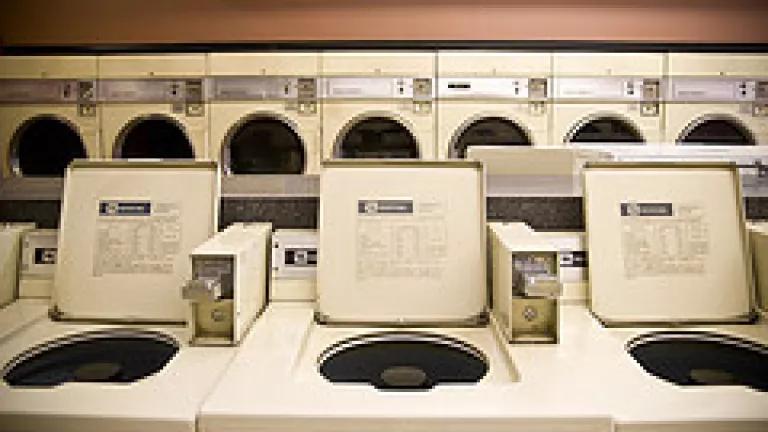
Although most U.S. families wash their clothes at home, the laundry needs of about one out of five households are met by commercial washers in self-service laundromats and the laundry rooms of apartments and dorms. And now, the government has proposed increasing the standards for the energy- and water-efficiency of commercial washers, but only a little bit.
Efficiency rules for these appliances were first enacted in 2005, and revised in 2010. In
the March 4 Federal Register, the Department of Energy proposed an additional update, which it believes over the next 30 years will save the equivalent of 0.6 percent of total U.S. commercial energy use in 2012. DOE also estimates that the average owner of new commercial washers could save between $145 and $285 over the machine’s life. Overall, the net savings from all new commercial washers purchased between 2018 and 2047 could reach Traditional commercial top-loaders nearly $1 billion on a present value basis. The proposed rule would also cut carbon dioxide emissions by nearly 6 million metric tons over this period. But a stronger standard for commercial washers could save even more.
Two kinds of washers
As with residential washers, commercial washers come in two formats: top-loading and front-loading. And just like residential washers, front-loading washers are much more energy- and water-efficient than traditional top-loaders.
A front-loading washer continuously drops clothes into a small pool of water and lifts them out, gently dropping and lifting to loosen soil throughout the cycle. A traditional top loader submerges clothes in a deep tub of water and then pounds away with a center agitator to loosen soil from clothing – a design that has changed little since the days of black-and-white television. Manufacturers have introduced water- and energy-saving features into new top-loaders for residential use, but have clung to the traditional inefficienct design for commercial top-loaders.
Front-loaders operate with far less water than traditional top-loaders – often 50% to 60% less. And since much of the energy used to wash clothes goes toward heating the wash water, front-loaders are much more energy-efficient as well.
When researching this proposed rule, DOE got feedback from NRDC, the Appliance Standards Awareness Project, and three major California utilities. We urged that DOE write one rule for all commercial washers because the method of loading makes little difference to machine owners. But DOE responded that the method of loading the machine “represents a distinct consumer utility-related feature” that demands separate product classes for top- and front-loading washers. For commercial washers, the “consumer” is the owner or lessor of the machine. In its previous rulemaking, DOE had based its decision to establish separate product classes on its perception of a wide discrepancy in cycle time – with front loaders supposedly taking 20 to 30 minutes longer to complete a wash cycle, and thus available for far fewer vended turns per day, netting less revenue for machine owners.
However, in preparing to revise the standards and in response to the comments noted above, DOE investigated this issue more closely and found that cycle times are actually quite comparable, and that the perceived disparity had shrunk to just 4 minutes – an average of 30 minutes for top-loaders and 34 minutes for front-loaders. Yet DOE still concluded that this is significant enough to justify maintaining a separate, less stringent product class for top-loaders.
Federal energy and water efficiency standards for top-loading commercial washers are currently far less stringent than for front-loaders. The new standards proposed by DOE would maintain this disparity. They would allow top-loaders to use 65% more electricity, 62% more natural gas, and 130% more water than front-loading commercial washers. Thus the resource cost for accommodating the continued sale of inefficient top-loaders is stark, while the benefit for doing so is unclear. And as serious to extreme drought extends across much of the country, the irony of DOE bending over backwards to accommodate a wasteful class of commercial clothes washers will not be lost.
DOE said it also considered higher energy efficiency levels, and is still considering them. However, DOE has tentatively concluded that the potential burdens of the higher energy efficiency standards would outweigh the projected benefits. In its filing with the Federal Register, DOE also said that products achieving these standard levels are already commercially available for the machines that would be covered by the proposed rule.
Efficiency standards moving forward
While the proposed rule leaves savings on the table in its current form, we’re pleased to see DOE moving forward with this and other recently issued standards. Publication of the proposed rule shows that the Obama administration is committed to the Climate Action Plan goal it set last summer to achieve 3 billion metric tons of carbon dioxide pollution reductions from efficiency standards by 2030. Since last August, the DOE has issued proposed standards for commercial refrigerators, walk-in coolers and freezers, metal halide lamps, furnace fans, ice makers, and the electric motors that gobble half of the electricity used by industry in the United States.
For its new proposed rule on commercial clothes washers, DOE will hold a public meeting April 21 in Washington, D.C., and will take public comments until May 5. The final version of this standard must be published by next January.
My colleague Ben Chou's recent post on residential clothes washers can be seen here.
Photo credit: Christine Mullen, www.christinemullen.com

